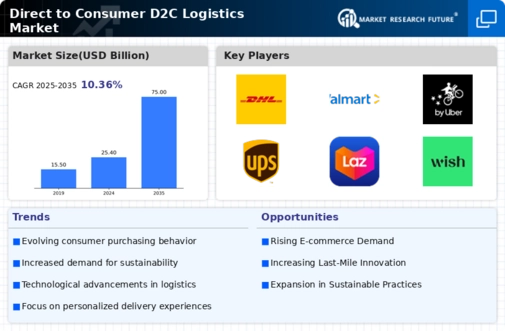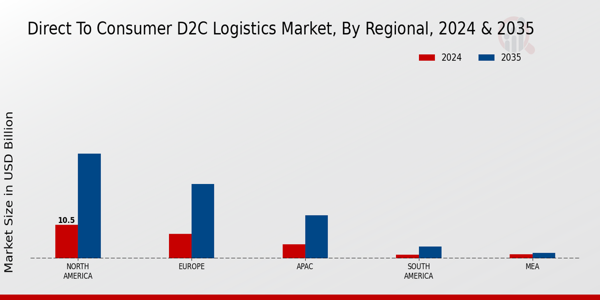Rising E-commerce Demand
The Global Direct to Consumer D2C Logistics Market Industry is experiencing a surge in demand driven by the rapid growth of e-commerce. As consumers increasingly prefer online shopping, logistics providers are adapting to meet the needs of direct-to-consumer models. In 2024, the market is projected to reach 25.4 USD Billion, reflecting the shift in consumer behavior towards digital platforms. This trend is likely to continue, with the market expected to expand significantly by 2035, potentially reaching 75 USD Billion. The increasing reliance on efficient logistics solutions is critical for businesses aiming to capitalize on this e-commerce boom.
Market Growth Projections
The Global Direct to Consumer D2C Logistics Market Industry is poised for substantial growth, with projections indicating a market size of 25.4 USD Billion in 2024 and an anticipated increase to 75 USD Billion by 2035. This growth trajectory suggests a robust compound annual growth rate (CAGR) of 10.36% from 2025 to 2035. Such figures highlight the increasing importance of logistics in facilitating direct-to-consumer sales, as businesses seek to optimize their supply chains and enhance customer experiences. The market's expansion reflects broader trends in consumer behavior and technological advancements that are reshaping the logistics landscape.
Sustainability Initiatives
Sustainability is becoming a pivotal driver in the Global Direct to Consumer D2C Logistics Market Industry. As consumers become more environmentally conscious, companies are compelled to adopt sustainable practices in their logistics operations. This includes optimizing transportation routes to reduce carbon footprints and utilizing eco-friendly packaging materials. The integration of sustainability into logistics not only meets consumer demands but also enhances brand reputation. As the market evolves, companies that prioritize sustainability are likely to attract a larger customer base, contributing to the projected growth of the market to 75 USD Billion by 2035.
Technological Advancements
Technological innovations are transforming the Global Direct to Consumer D2C Logistics Market Industry, enhancing efficiency and customer experience. Automation, artificial intelligence, and data analytics are becoming integral to logistics operations, enabling companies to optimize their supply chains. For instance, AI-driven demand forecasting can significantly reduce delivery times and costs. As logistics providers adopt these technologies, they can better manage inventory and streamline operations. The anticipated growth of the market, with a CAGR of 10.36% from 2025 to 2035, underscores the importance of technology in maintaining competitiveness in the evolving landscape of D2C logistics.
Global Supply Chain Resilience
The Global Direct to Consumer D2C Logistics Market Industry is increasingly focused on building resilient supply chains. Recent disruptions have highlighted the vulnerabilities within global logistics networks, prompting companies to reassess their strategies. By diversifying suppliers and enhancing inventory management, businesses can mitigate risks associated with supply chain disruptions. This resilience is crucial for maintaining service levels and customer satisfaction in the D2C model. As companies invest in strengthening their supply chains, the market is expected to grow, reflecting the importance of adaptability in logistics operations.
Consumer Expectations for Fast Delivery
In the Global Direct to Consumer D2C Logistics Market Industry, consumer expectations for rapid delivery are reshaping logistics strategies. Today's consumers demand not only quality products but also swift shipping options, often expecting same-day or next-day delivery. This shift compels logistics providers to enhance their operational capabilities, leading to the implementation of advanced warehousing and distribution networks. Companies that can meet these expectations are likely to gain a competitive edge in the market. As the industry adapts to these demands, the market is projected to grow significantly, reflecting the increasing importance of speed in logistics.
























Leave a Comment